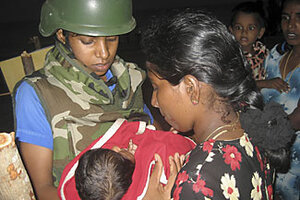Sri Lanka: dispute over how to help civilians in war zone
Caution is guiding the international response as fighting intensifies between the government and the rebels.

AID: A Sri Lankan Navy medic with an injured Tamil baby. The Red Cross evacuated about 450 Tamils from a rebel area Monday.
REUTERS
BANGKOK, THAILAND
As fighting between government troops and Tamil Tiger rebels intensifies in northeast Sri Lanka, calls to spare as many as 180,000 trapped civilians are growing. But in the debate over how far to push a warring government, caution is guiding the international response.
Last week, Secretary of State Hillary Clinton voiced "deep concern" to Sri Lanka over rising civilian casualties in a government-designated no-fire zone. The Red Cross, which normally prefers quiet persuasion to arm-twisting, has raised the alarm over a humanitarian crisis in the remaining pocket of rebel-held territory, where makeshift hospitals are out of needed drugs and food supplies are dwindling.
But this outcry has failed to sway Sri Lanka's government, which dismisses its critics as biased and reliant on propaganda from the Liberation Tigers of Tamil Eelam (LTTE), which has fought a bloody war for self-rule since 1983. Government officials defend the military's conduct in pushing back the rebels and say the onus is on the LTTE to let civilians flee the conflict, not use them as shields or force them to fight.
Behind the diplomatic exchanges are divisions within the international community over the proper response to apparent violations of international law by both sides. Far from pressing hard for action, some United Nations officials have muffled internal reporting from the war zone, to the frustration of aid workers and human rights activists who accuse the UN of cowardice in the face of a belligerent government.
UN High Commissioner for Human Rights Navi Pillay broke ranks on Friday. In a stern statement, she said that 2,800 civilians may have died and more than 7,000 been injured since Jan. 20. Most of these casualties occurred in the 7-1/2-mile-long no-fire zone and were the result of Army shelling. Certain actions by the warring parties "may constitute violations of international human rights and humanitarian law."
"The current level of civilian casualties is truly shocking, and there are legitimate fears that the loss of life may reach catastrophic levels, if the fighting continues this way," she said.
Sri Lankan officials promptly denied the allegations. Minister of Human Rights Mahinda Samarasinghe criticized the use of "unsubstantiated statistics" in an "unprofessional statement," and questioned why the data were similar to those used by pro-LTTE websites.
In fact, the sensitive data aired by Ms. Pillay were based on firsthand daily reporting by UN national staff and aid workers trapped in the no-fire zone. A copy of a recent UN briefing paper that was obtained by the Monitor listed similar casualty figures and described mounting casualties in the squalid, densely packed coastal strip. "Daily incoming artillery and mortar fire has caused large number of casualties with a noted increase since 26 Feb," it said.
The briefing paper said several weeks of food and medicine shortages had led to deaths from malnutrition and from preventable diseases. On Tuesday, the Red Cross said a relief ship carrying 500 tons of food aid had arrived in the no-fire zone but warned of a growing risk of disease outbreaks.
Senior UN officials in Sri Lanka are reluctant to go toe-to-toe with the government in its hour of near-victory over the LTTE, say diplomats and aid workers. Just as in Sudan, where a war-crimes indictment has triggered vengeful expulsions of foreign aid groups, a confrontational approach may backfire at a time when many aid agencies are gearing up for post-conflict reconstruction.
"The UN has to walk a fine line here," says a senior Western diplomat in Colombo who was briefed on the casualty figures.
Donors are also frustrated by the tactics of the LTTE, which is forcibly recruiting boys and girls to fight and moving its heavy guns into the no-fire zone, effectively provoking retaliation against civilians. Far from laying down their arms, the leadership may be preparing to make a final stand and hope that mass civilian deaths trigger international pressure for a cease-fire, over the wishes of the government.
Foreign Secretary Palitha Kohona, a former UN diplomat, describes the Human Rights Commission report as partisan. He also questions the accuracy of its casualty figures, given the chaos of the war zone and the pressures on ethnic Tamil aid workers there. The UN has said that the LTTE has forcibly recruited at least two of its staff as combatants.
"In a situation like this, it's very difficult to get a clear picture," Mr. Kohona says.
In her statement, Ms. Pillay called for a suspension of fighting to allow for the evacuation of noncombatants. More than 40,000 have already fled in recent months, in defiance of LTTE intimidation, and are being resettled in government-run camps. The UN estimates that between 150,000 and 180,000 civilians are still trapped behind enemy lines, though the government says the number is closer to 50,000.
Many of the displaced have been driven from the homes repeatedly during two years of military offensives against the LTTE, which is designated by the US and other Western governments as a terrorist organization. Last week, a suspected LTTE suicide bomber struck in the south of Sri Lanka, an attack that critically wounded a government minister and killed 14 people.
